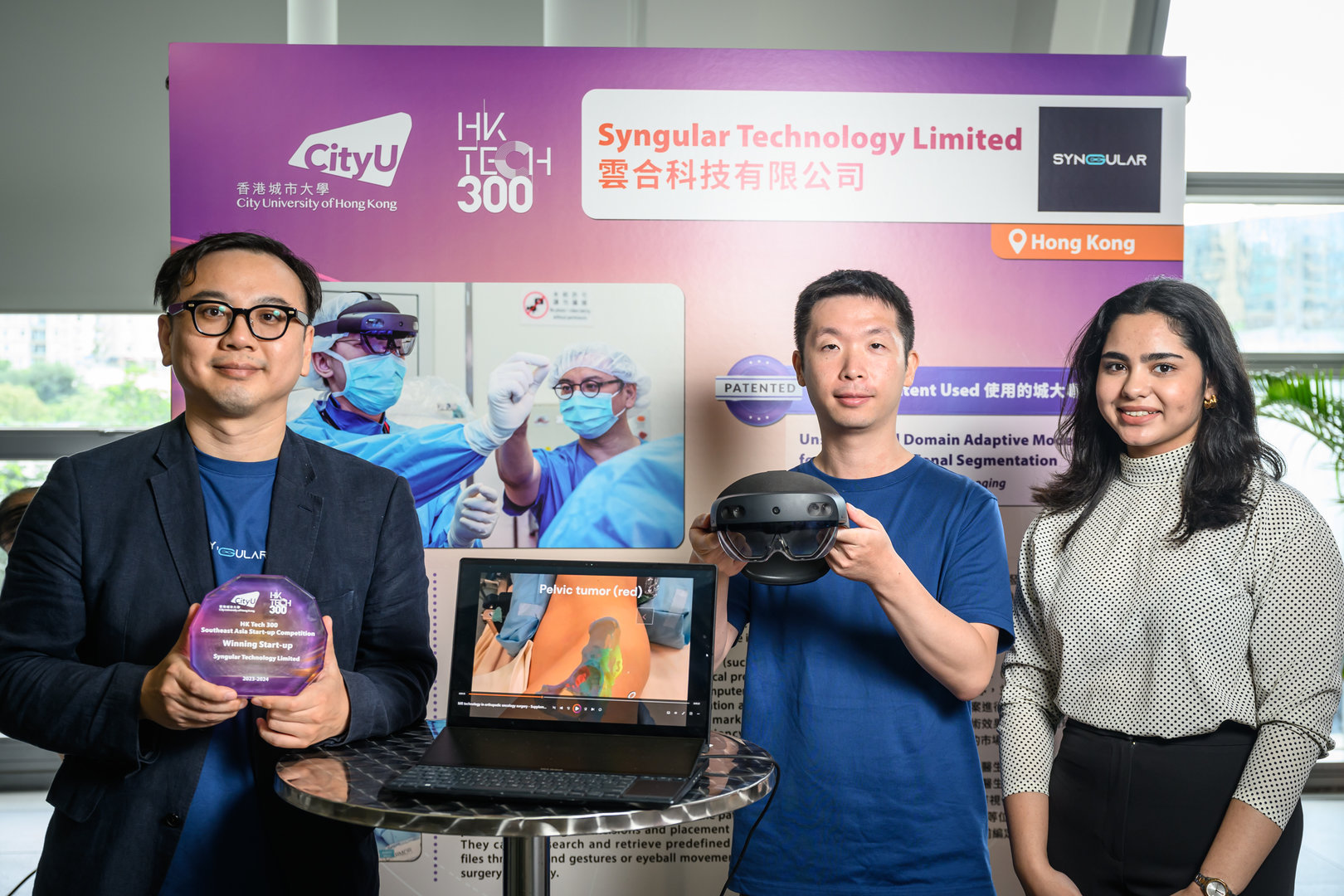In recent years, the application of mixed reality (MR) has evolved from gaming to various professional settings, including commercial and medical applications. Syngular Technology, founded in 2021, specialises in the development of MR surgical assistance software. By wearing MR glasses equipped with this software during operations, surgeons can instantly compare 3D medical images of patients as if they were able to see through them. This helps doctors ensure that surgical procedures are carried out accurately. This innovative product has been trialled in a Hong Kong public hospital.

Syngular Technology was founded by Mr Louis Sze, a PhD student in the College of Business of City University of Hong Kong (CityUHK). It was a start-up incubated by HK Tech 300 with HK$1 million of angel fund investment and was subsequently admitted to Hong Kong Science and Technology Parks Corporation’s (Science Park) Incu-bio programme, which offers up to HK$6 million in funding.
Using MR to improve surgical planning and efficiency
Louis, who has a master’s degree in biomedical engineering and is pursuing a PhD in Business Administration at CityUHK, has over a decade of experience in medical 3D printing and design. He is aware of the urgent demand for new technologies among his clientele, including surgeons.
He pointed out that surgeons rely primarily on 2D images (such as X-rays) or 3D physical models when planning operations. However, creating these models often requires sending patient data to external units, which can take several days and makes it difficult to precisely plan the placement of implants and procedures. During surgery, doctors also need to have assistants help them shuffle back and forth between the operating table and the computer, comparing pre-operative images with the patient’s current physical condition to ensure accuracy in all steps of the operation.

Louis said, “As early as in 2017, we noticed that MR technology could potentially be used in surgery to provide a highly automated, interactive visualisation of medical images. However, the hardware available at the time wasn’t up to the task. It wasn’t until 2019, when a new version of MR glasses was released with improvements in weight and computing power over the previous generation, that my two co-founders and I immediately envisioned doctors wearing these MR glasses to perform surgery. So we established the company in 2021, formed a team to develop the product in 2022, and launched the first version in 2023.”
Working with game development experts to synchronise reality and 3D medical images
The two co-founders Louis mentioned are both game development experts and leaders in the field of e-sports-grade 3D visualisation and software engineering.
The team developed the Syngular MR Platform, which uses AI algorithms to automate the 3D modelling process and generate 3D holograms from 2D medical images, such as MRI or CT scans in DICOM format. Originally, DICOM was just a set of black and white images. After AI computation and analysis, it can be transformed into a 3D model that meticulously recreates bones, muscles, organs and blood vessels, and even marks tumour locations. The model reconstruction process has been reduced from days to about 30 minutes, with a level of detail surpassing 3D printed models.
Using the platform, doctors can input medical images to generate personalised 3D scenes and plan surgical procedures. By wearing MR glasses during surgery, doctors can achieve “intuitive X-ray vision”. “For example, a doctor wearing MR glasses during surgery can overlay MRI or CT images onto the patient’s body and mark the corresponding tumour location on the skin,” explained Louis.
Eye movements and hand gestures control surgical models in MR glasses
Doctors can use gestures and eye movements to control the surgical model in the MR glasses during surgery to understand the different structures of organs and instantly access relevant files pre-loaded into the system. With the help of MR software, complex tumour surgeries can be shortened by from 10% to 20%, thus improving surgical efficiency.
In addition, the video camera on the MR glasses can transmit live surgery footage to remote users, while building a database that can aid medical research, teaching and training in the long term.
HK Tech 300 helps develop a product prototype for public hospital trials

Founded in 2021, Syngular Technology received angel investment from the HK Tech 300 programme in 2022. Louis appreciated the programme’s support, which enabled the company to complete its first product prototype more quickly and accelerated its opportunity to enter Science Park, where it connected with Hong Kong’s Hospital Authority through an online exhibition. The team’s product is currently being trialled in a public hospital in Hong Kong, primarily to support bone tumour and neurosurgery operations. It can also address medical needs in ear, nose and throat, dentistry, plastic surgery and scoliosis. The team is also providing solutions for one of Hong Kong’s universities to livestream A&E situations for students to view and is developing physiotherapy-related tools for Australian clients for educational purposes.
“All our team members want to use their talent not only for MR entertainment; we want to expand MR software applications to meet societal needs. Our technology can facilitate and support the surgical work of doctors, improving efficiency to achieve the goal of ‘enabling humans’,” Louis added.
The team won the “Gold Medal with Congratulations of the Jury” at the 48th International Exhibition of Inventions Geneva and was one of the winners of the HK Tech 300 Southeast Asia Start-up Competition. The company applies CityUHK patents to improve its products and is currently applying for US FDA Class II Medical Device certification and other similar accreditation. They are looking to develop more features, including a collaborative model for multiple doctors and AI tumour model reconstruction, to expand into mainland China and overseas markets.
July 2024